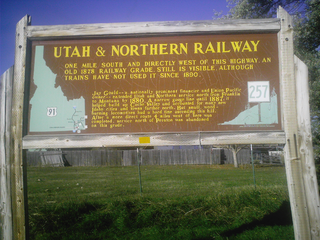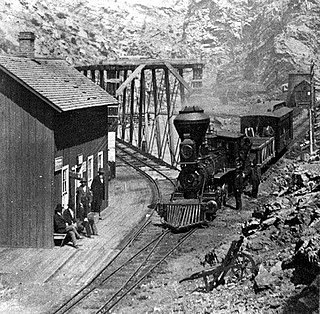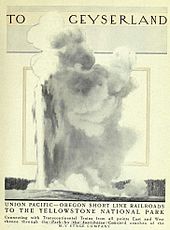
A transcontinental railroad or transcontinental railway is contiguous railroad trackage, that crosses a continental land mass and has terminals at different oceans or continental borders. Such networks can be via the tracks of either a single railroad or over those owned or controlled by multiple railway companies along a continuous route. Although Europe is crisscrossed by railways, the railroads within Europe are usually not considered transcontinental, with the possible exception of the historic Orient Express. Transcontinental railroads helped open up unpopulated interior regions of continents to exploration and settlement that would not otherwise have been feasible. In many cases they also formed the backbones of cross-country passenger and freight transportation networks. Many of them continue to have an important role in freight transportation and some like the Trans-Siberian Railway even have passenger trains going from one end to the other.

The Portland and Willamette Valley Railway was incorporated on 19 January 1885 to continue construction of a 3 ft narrow-gauge railroad line between Portland and Dundee, Oregon, United States, which had been started a few years earlier by the Oregonian Railway. The line was opened on 31 December 1886 and the first timetables were published the following day; however, the line did not reach Portland until 23 July 1888, due to disputes over the right-of-way. The railroad company ran this line until it fell into receivership on 2 February 1892.

The Utah & Northern Railway is a defunct railroad that was operated in the Utah Territory and later in the Idaho Territory and Montana Territory in the western United States during the 1870s and 1880s. It was the first railroad in Idaho and in Montana. The line was acquired by a Union Pacific Railroad subsidiary, the Oregon Short Line, and is today operated by the Union Pacific Railroad as the Ogden Subdivision, part of the Pocatello Subdivision, and the Montana Subdivision.
Short Line or Shortline can refer to:

The Colorado Central Railroad was a U.S. railroad company that operated in Colorado and southeastern Wyoming in the late 19th century. It was founded in the Colorado Territory in the wake of the Colorado Gold Rush to ship gold from the mountains. It expanded from its Golden–Denver line to form a crucial link connecting Colorado with the transcontinental railroad and the national rail network. The history of the railroad throughout the 1870s was driven at times by a fierce struggle between local interests, led by W.A.H. Loveland, and outside investors of the Union Pacific Railroad led at times by Jay Gould. The early struggle of the company to build its lines was a major part of the early competition between Denver and Golden for supremacy as the principal metropolis of Colorado.

The Arkansas, Louisiana and Mississippi Railroad is a 52.9-mile (85.1 km) short-line railroad in northern Louisiana and southern Arkansas. Opened in 1908, it has undergone several corporate reorganizations, but has remained independent of larger carriers. In 2004, paper producer Georgia-Pacific sold the company to shortline operator Genesee & Wyoming Inc. Traffic generally consists of lumber, paper, forest products, and chemicals.

The Sumpter Valley Railway, or Sumpter Valley Railroad, is a 3 ft narrow gauge heritage railroad located in Baker County, in the U.S. state of Oregon. Built on a right-of-way used by the original railway of the same name, it carries excursion trains on a roughly 5-mile (8.0 km) route between McEwen and Sumpter. The railroad has two steam locomotives and several other pieces of rolling stock. Passenger excursion trains operate on weekends and holidays from Memorial Day through the end of September.

The Idaho Northern and Pacific Railroad is a small railroad in southwestern Idaho and eastern Oregon in the United States. It owns 120 miles (190 km) of former Union Pacific Railroad branch lines, and is a subsidiary of the Rio Grande Pacific Corp., based in Fort Worth, Texas. Idaho Northern and Pacific's offices are in Emmett, Idaho.

The Spokane International Railroad was a short line railroad between Spokane, Washington, and the Canadian Pacific Railway (CP) at Kingsgate, British Columbia. The line became an important one for the CP with its connections to the Union Pacific Railroad and Portland, Oregon.
The Savannah, Americus and Montgomery Railway (SA&M) was a historic railroad located in the U.S. states of Georgia and Alabama. SA&M was built in the 1880s running between Montgomery, Alabama and Lyons, Georgia. It would be completed to Savannah, Georgia in 1896 after being renamed the Georgia and Alabama Railway. The line would notably become part of the Seaboard Air Line Railroad network in 1900.
The Salt Lake City Southern Railroad is a 25-mile (40 km) short-line railroad operating between Salt Lake City, and Murray, in Utah, United States. The SL began operating on April 19, 1993, as a RailTex subsidiary. Today the SL is a subsidiary of the Utah Railway and is owned by the Genesee & Wyoming Inc.
The Lake Tahoe Railway and Transportation Company was a 16-mile (26 km), 3 ft narrow gauge railroad that ran from a connection with the Central Pacific Railway at Truckee, California to the waterfront at Lake Tahoe. The railroad was converted to 4 ft 8+1⁄2 instandard gauge in 1926. The railroad operated its own property from 1899 until October 16, 1925, at which time it was leased to the Southern Pacific Company, which bought the property outright in May 1933. SP abandoned the line in 1943.
The San Joaquin and Sierra Nevada Railroad was originally built as a 3 ft narrow gauge that ran from Bracks Landing to Woodbridge and Lodi and then east to the Sierra Nevada foothill town of Valley Springs. The railroad was incorporated on March 28, 1882 and construction was completed on April 15, 1885. The railroad was built as a common carrier with copper mining being its primary traffic. The track was built using 35/40 lb steel rails.
The Lynndyl Subdivision is a rail line owned and operated by the Union Pacific Railroad in the U.S. state of Utah, running from Salt Lake City southwest to Milford, where the Caliente Subdivision continues towards Los Angeles. It was formerly part of the Los Angeles and Salt Lake Railroad and a section currently forms a segment of Union Pacific's Central Corridor. The subdivision is named for Lynndyl, a small community along the rail line. The highest elevation attained on the line is 6,061 feet (1,847 m) at Tintic. As of 2003 the line sees 16 trains daily between Lynndyl and Smelter.
The Utah Central Railroad was the first railroad in the U.S. state of Utah other than the main line of the First transcontinental railroad. Built by Mormons, it connected Salt Lake City to the transcontinental line at Ogden. It has since become part of the Union Pacific Railroad, which operates the line as the Salt Lake Subdivision; FrontRunner commuter rail tracks were added alongside the UP freight line in 2008.
The following is a brief history of the North American rail system, mainly through major changes to Class I railroads, the largest class by operating revenue.

The Oregon Eastern Railroad (OERR) is a railroad going from Ontario to Celetom Oregon. The railroad is all that is left of the Wyoming Colorado Railroad which started out as the Malheur Valley Railway. The railroad promotes itself as a "safe, reliable and economical method of transportation" and is proud of the fuel efficiency of railroads.

The Oregon Eastern Railway was a predecessor of the Southern Pacific Company that acquired or built most of the Natron Cutoff in northern California and southern Oregon, United States. It also made surveys and acquired right-of-way in eastern Oregon, which were subsequently sold to Union Pacific Railroad subsidiary Oregon–Washington Railroad and Navigation Company.
The Carolina & Northwestern Railway (Ca&NW) was a railroad that served South Carolina and North Carolina from 1897 until January 1, 1974. The original line was operated by the Ca&NW as a separate railroad controlled by the Southern Railway until 1974 when the name was changed to the Norfolk Southern Railway. On June 1, 1982, Southern Railway and Norfolk and Western Railroad merged to form Norfolk Southern Railway. Choosing to use the name 'Norfolk Southern Railway' for the merger, in 1981, the original Ca&NW line along with original Norfolk Southern Railway was renamed Carolina and Northwestern once again. In the early 1950s several shortline subsidiaries of the Southern Railway were leased to the Ca&NW for operation, with these lines remaining a part of the Ca&NW into the 1980s.

The Ontario station is a former train station located in Ontario, Oregon, United States that is listed on the National Register of Historic Places as the Oregon Short Line Railroad Depot. It was constructed in 1907 by the Union Pacific Railroad (UP) for its subsidiary, the Oregon Short Line Railroad (OSL), to replace an 1885 OSL depot that had been located just to the south and had been a simple wood-frame structure. The building is made of concrete block cast to imitate stone, and with red brick trim and other ornamental features. The City of Ontario purchased the building from UP in 1996, but as of 1999 the land remained owned by UP and was being leased to the city. The station was added to the NRHP in 1999.














